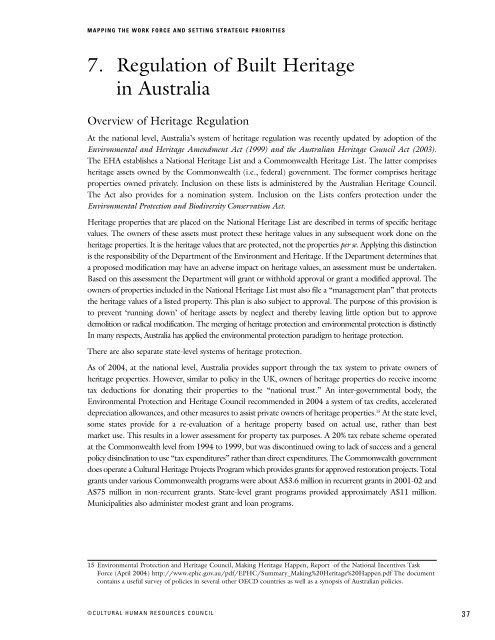Human Resources in Canada's Built Heritage Sector: Mapping the ...
Human Resources in Canada's Built Heritage Sector: Mapping the ...
Human Resources in Canada's Built Heritage Sector: Mapping the ...
- No tags were found...
Create successful ePaper yourself
Turn your PDF publications into a flip-book with our unique Google optimized e-Paper software.
MAPPING THE WORK FORCE AND SETTING STRATEGIC PRIORITIES7. Regulation of <strong>Built</strong> <strong>Heritage</strong><strong>in</strong> AustraliaOverview of <strong>Heritage</strong> RegulationAt <strong>the</strong> national level, Australia’s system of heritage regulation was recently updated by adoption of <strong>the</strong>Environmental and <strong>Heritage</strong> Amendment Act (1999) and <strong>the</strong> Australian <strong>Heritage</strong> Council Act (2003).The EHA establishes a National <strong>Heritage</strong> List and a Commonwealth <strong>Heritage</strong> List. The latter comprisesheritage assets owned by <strong>the</strong> Commonwealth (i.e., federal) government. The former comprises heritageproperties owned privately. Inclusion on <strong>the</strong>se lists is adm<strong>in</strong>istered by <strong>the</strong> Australian <strong>Heritage</strong> Council.The Act also provides for a nom<strong>in</strong>ation system. Inclusion on <strong>the</strong> Lists confers protection under <strong>the</strong>Environmental Protection and Biodiversity Conservation Act.<strong>Heritage</strong> properties that are placed on <strong>the</strong> National <strong>Heritage</strong> List are described <strong>in</strong> terms of specific heritagevalues. The owners of <strong>the</strong>se assets must protect <strong>the</strong>se heritage values <strong>in</strong> any subsequent work done on <strong>the</strong>heritage properties. It is <strong>the</strong> heritage values that are protected, not <strong>the</strong> properties per se. Apply<strong>in</strong>g this dist<strong>in</strong>ctionis <strong>the</strong> responsibility of <strong>the</strong> Department of <strong>the</strong> Environment and <strong>Heritage</strong>. If <strong>the</strong> Department determ<strong>in</strong>es thata proposed modification may have an adverse impact on heritage values, an assessment must be undertaken.Based on this assessment <strong>the</strong> Department will grant or withhold approval or grant a modified approval. Theowners of properties <strong>in</strong>cluded <strong>in</strong> <strong>the</strong> National <strong>Heritage</strong> List must also file a “management plan” that protects<strong>the</strong> heritage values of a listed property. This plan is also subject to approval. The purpose of this provision isto prevent ‘runn<strong>in</strong>g down’ of heritage assets by neglect and <strong>the</strong>reby leav<strong>in</strong>g little option but to approvedemolition or radical modification. The merg<strong>in</strong>g of heritage protection and environmental protection is dist<strong>in</strong>ctlyIn many respects, Australia has applied <strong>the</strong> environmental protection paradigm to heritage protection.There are also separate state-level systems of heritage protection.As of 2004, at <strong>the</strong> national level, Australia provides support through <strong>the</strong> tax system to private owners ofheritage properties. However, similar to policy <strong>in</strong> <strong>the</strong> UK, owners of heritage properties do receive <strong>in</strong>cometax deductions for donat<strong>in</strong>g <strong>the</strong>ir properties to <strong>the</strong> “national trust.” An <strong>in</strong>ter-governmental body, <strong>the</strong>Environmental Protection and <strong>Heritage</strong> Council recommended <strong>in</strong> 2004 a system of tax credits, accelerateddepreciation allowances, and o<strong>the</strong>r measures to assist private owners of heritage properties. 15 At <strong>the</strong> state level,some states provide for a re-evaluation of a heritage property based on actual use, ra<strong>the</strong>r than bestmarket use. This results <strong>in</strong> a lower assessment for property tax purposes. A 20% tax rebate scheme operatedat <strong>the</strong> Commonwealth level from 1994 to 1999, but was discont<strong>in</strong>ued ow<strong>in</strong>g to lack of success and a generalpolicy dis<strong>in</strong>cl<strong>in</strong>ation to use “tax expenditures” ra<strong>the</strong>r than direct expenditures. The Commonwealth governmentdoes operate a Cultural <strong>Heritage</strong> Projects Program which provides grants for approved restoration projects. Totalgrants under various Commonwealth programs were about A$3.6 million <strong>in</strong> recurrent grants <strong>in</strong> 2001-02 andA$75 million <strong>in</strong> non-recurrent grants. State-level grant programs provided approximately A$11 million.Municipalities also adm<strong>in</strong>ister modest grant and loan programs.15 Environmental Protection and <strong>Heritage</strong> Council, Mak<strong>in</strong>g <strong>Heritage</strong> Happen, Report of <strong>the</strong> National Incentives TaskForce (April 2004) http://www.ephc.gov.au/pdf/EPHC/Summary_Mak<strong>in</strong>g%20<strong>Heritage</strong>%20Happen.pdf The documentconta<strong>in</strong>s a useful survey of policies <strong>in</strong> several o<strong>the</strong>r OECD countries as well as a synopsis of Australian policies.©CULTURAL HUMAN RESOURCES COUNCIL37










